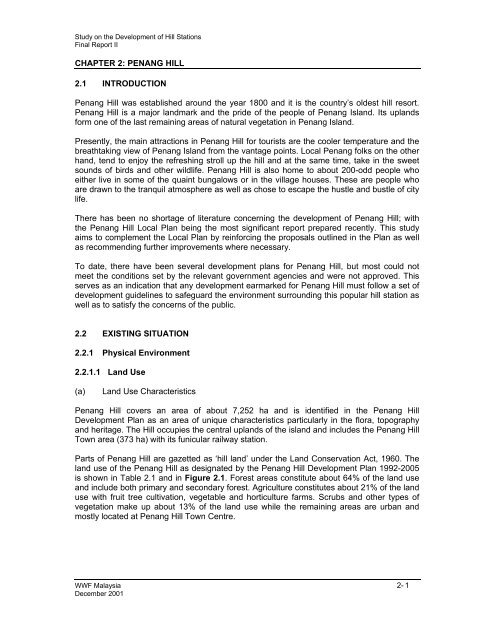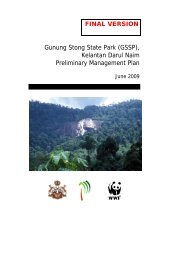WWFM_Hill Stations Study Vol2_2001.pdf - Sdn Bhd - WWF Malaysia
WWFM_Hill Stations Study Vol2_2001.pdf - Sdn Bhd - WWF Malaysia
WWFM_Hill Stations Study Vol2_2001.pdf - Sdn Bhd - WWF Malaysia
You also want an ePaper? Increase the reach of your titles
YUMPU automatically turns print PDFs into web optimized ePapers that Google loves.
<strong>Study</strong> on the Development of <strong>Hill</strong> <strong>Stations</strong><br />
Final Report II<br />
CHAPTER 2: PENANG HILL<br />
2.1 INTRODUCTION<br />
Penang <strong>Hill</strong> was established around the year 1800 and it is the country’s oldest hill resort.<br />
Penang <strong>Hill</strong> is a major landmark and the pride of the people of Penang Island. Its uplands<br />
form one of the last remaining areas of natural vegetation in Penang Island.<br />
Presently, the main attractions in Penang <strong>Hill</strong> for tourists are the cooler temperature and the<br />
breathtaking view of Penang Island from the vantage points. Local Penang folks on the other<br />
hand, tend to enjoy the refreshing stroll up the hill and at the same time, take in the sweet<br />
sounds of birds and other wildlife. Penang <strong>Hill</strong> is also home to about 200-odd people who<br />
either live in some of the quaint bungalows or in the village houses. These are people who<br />
are drawn to the tranquil atmosphere as well as chose to escape the hustle and bustle of city<br />
life.<br />
There has been no shortage of literature concerning the development of Penang <strong>Hill</strong>; with<br />
the Penang <strong>Hill</strong> Local Plan being the most significant report prepared recently. This study<br />
aims to complement the Local Plan by reinforcing the proposals outlined in the Plan as well<br />
as recommending further improvements where necessary.<br />
To date, there have been several development plans for Penang <strong>Hill</strong>, but most could not<br />
meet the conditions set by the relevant government agencies and were not approved. This<br />
serves as an indication that any development earmarked for Penang <strong>Hill</strong> must follow a set of<br />
development guidelines to safeguard the environment surrounding this popular hill station as<br />
well as to satisfy the concerns of the public.<br />
2.2 EXISTING SITUATION<br />
2.2.1 Physical Environment<br />
2.2.1.1 Land Use<br />
(a)<br />
Land Use Characteristics<br />
Penang <strong>Hill</strong> covers an area of about 7,252 ha and is identified in the Penang <strong>Hill</strong><br />
Development Plan as an area of unique characteristics particularly in the flora, topography<br />
and heritage. The <strong>Hill</strong> occupies the central uplands of the island and includes the Penang <strong>Hill</strong><br />
Town area (373 ha) with its funicular railway station.<br />
Parts of Penang <strong>Hill</strong> are gazetted as ‘hill land’ under the Land Conservation Act, 1960. The<br />
land use of the Penang <strong>Hill</strong> as designated by the Penang <strong>Hill</strong> Development Plan 1992-2005<br />
is shown in Table 2.1 and in Figure 2.1. Forest areas constitute about 64% of the land use<br />
and include both primary and secondary forest. Agriculture constitutes about 21% of the land<br />
use with fruit tree cultivation, vegetable and horticulture farms. Scrubs and other types of<br />
vegetation make up about 13% of the land use while the remaining areas are urban and<br />
mostly located at Penang <strong>Hill</strong> Town Centre.<br />
<strong>WWF</strong> <strong>Malaysia</strong> 2- 1<br />
December 2001
















